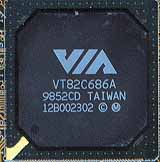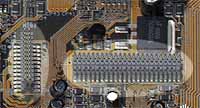The Super South Bridge
| A fitting name for a deserving product, the second part to the MVP4 equation is the VT82C686 Super South Bridge controller. The South Bridge has generally been the home to the PCI Hard Disk controller and other such I/O related functions, and in an extension of tradition, VIA has taken the standard South Bridge one step further with their Super South Bridge present as a part of the MVP4 chipset. |  |
Starting with its primary function, the Super South Bridge contains the same Ultra DMA/33 PCI EIDE Bus Master controller that the MVP3's South Bridge features with a new twist, support for the new Ultra ATA-66 standard. As you all are probably already aware of, the maximum theoretical transfer rate on an Ultra ATA-33 hard disk is, as the name implies, 33.3MB/s. The Ultra ATA-66 standard doubles that maximum theoretical burst transfer rate to 66.6MB/s while increasing the cable specifications to call for a 40-pin/80-conductor cable (as opposed to the standard 40-pin/40-conductor cables) to improve data integrity during high speed data transfers. For a more in-depth description of Ultra ATA-66, read Western Digital's Overview of the Standard.
At the time of publication, AnandTech did not have the opportunity to benchmark an Ultra ATA-66 vs Ultra ATA-33 comparison, however VIA has an updated set of Bus Master drivers with official Ultra ATA-66 support in the works, so rest assured that AnandTech will bring you a full fledged comparison as soon as the drivers are ready.
Leaving hard disk controllers behind, the Super South Bridge adds another unique feature to the already extensive support list, USB2. Towards the end of 1998, a few motherboards began popping up that had support for front USB ports, unfortunately using a USB port on the front of your case would require that one be taken off of the back of your case. The addition of USB2 allows for an additional 2 ports to be supported on the motherboard itself, bringing the total supported USB ports to 4 ports (ideally, 2 front and 2 back), and with each port supporting a theoretical maximum of 127 devices, that's a total of 508 devices. Chances are you'll never come close to reaching that limit (there aren't enough USB devices in existence to reach that limit), but it's better to be safe with an unreasonable limit than to begin finding ways to cut down on USB devices.
In spite of VIA's extensive work on an integrated IEEE1394 solution (Firewire), the up and coming standard failed to make it into the Super South Bridge of the MVP4. When AnandTech asked about the possibility of including Firewire in a later revision of the chipset VIA indicated that if the technology were integrated into the South Bridge controller, a relatively smooth integration could be performed by simply replacing the South Bridge chip with an updated release including 1394 support. It seems like only time will tell, but don't be too surprised if the second half of 1999 holds 1394 integration with some of VIA's chipsets.
Why call the VT82C686 controller a Super South Bridge controller? For no reason other than the integrated audio and modem CODECs that the Super South Bridge controller houses, allowing for extremely cost effective integration of on-board sound and modem connections with the possibility of integrated Ethernet controllers in the future if the demand is present. Once again, the modification of a South Bridge controller is hardly anything in comparison to a change in the North Bridge controller, simply because the South Bridge does not interact with any of the memory or video buses, leaving the South Bridge as a very flexible part of VIA's chipset solution.
| In order to help cut costs even more, Intel's AMR (Audio/Modem Riser) specification is used in interfacing with the on-board audio/modem CODECs. By using an external riser specification, a motherboard manufacturer does not have to wait for FCC certification for an integrated modem or audio controller in order to move on with production of the motherboard as the FCC certification can be more easily performed on the individual components rather than on a highly integrated motherboard. |  |
Although AMR integration does not border on the bleeding edge of technology in comparison to stand alone modem and sound solutions, the specification does set a baseline standard for audio and modem integration while cutting costs at the same time.










0 Comments
View All Comments